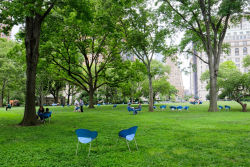The Battery
Coast Guard Memorial
What is this monument dedicated to?
The monument, depicting an interracial three-figure group in which two soldiers in fatigues bearing rifles support a wounded comrade in arms, honors those from the Coast Guard who served their country during World War II (1941–1945).
The United States Coast Guard was established in 1915 when the United States Revenue Cutter Service and Life Saving Service were combined into one administrative entity. Subsequently, functions formerly conducted by the Lighthouse Service, the Steamboat Inspection Service, and the Bureau of Navigation were incorporated into the mission of the Coast Guard.
This venerable maritime agency is charged with broad seaboard duties such as coastal safety, environmental protection, the enforcement of navigation rules, and the interdiction of illegal freight. Under the Department of the Treasury until 1967, today the Coast Guard is under the jurisdiction of the federal Department of Transportation during peacetime and under the control of the U.S. Navy in times of war.
The Coast Guard maintains an administrative facility at the Battery and a base on Staten Island.
How was this monument created?
The Coast Guard Memorial sculpture was created by Norman Millet Thomas (1915-1986). Thomas, a non-professional sculptor, was a painter and combat veteran who studied at the American Academy in Rome and with Paul Manship at the National Academy of Design in New York City. He based his composition on a rescue he had witnessed at the Luzon beachhead in the Philippines. Relying on a sketch Thomas submitted, the Coast Guard commissioned the sculpture through the contributions of thousands of servicemen and women.
First proposed in 1945, Thomas’ original design was declined by the New York City Art Commission. In 1954, a revised design in which Thomas introduced the central Black figure was approved by the Commission, and on Memorial Day, May 30, 1955 the inspirational sculpture was unveiled. At the ceremony Secretary of the Treasury George M. Humphrey and Admiral A. C. Richmond delivered remarks. Parks Commissioner Robert Moses, after bemoaning the “pointless controversies” and “yapping critics” that had almost scuttled the project, praised the artwork for its “manifest identity of sculptor and subject,” while noting, “It was conceived in war and dedicated to actual heroism.”
In 2021, as part of improvements to the Battery, the monument was installed in a newly created triangular plaza landscaped with native grasses and located adjacent to the Coast Guard building.
Check out your park's Vital Signs
Clean & Safe
Green & Resilient
Empowered & Engaged Users
Share your feedback or learn more about how this park is part of a
Vital Park System

Know Before You Go











